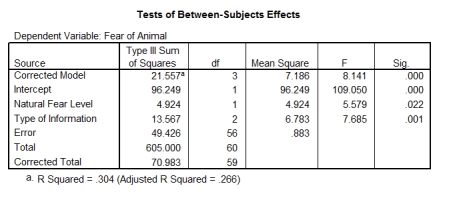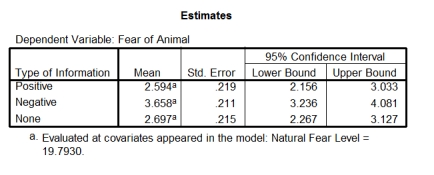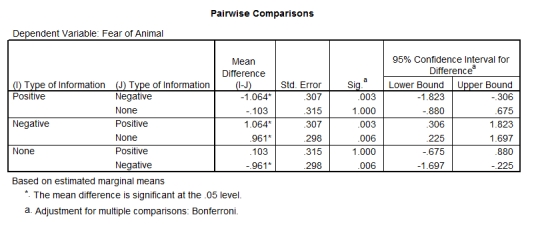Multiple Choice
A psychologist was interested in the effects of different fear information on children's beliefs about an animal. Three groups of children were shown a picture of an animal that they had never seen before (a quoll) . Then one group was told a negative story (in which the quoll is described as a vicious, disease-ridden bundle of nastiness that eats children's brains) , one group a positive story (in which the quoll is described as a harmless, docile creature who likes nothing more than to be stroked) , and a final group weren't told a story at all. After the story children rated how scared they would be if they met a quoll, on a scale ranging from 1 (not at all scared) to 5 (very scared indeed) . To account for the natural anxiousness of each child, a questionnaire measure of trait anxiety was given to the children and used in the analysis.
-Which of the following statements best reflects what the 'pairwise comparisons' tell us? 


A) Fear beliefs were significantly lower after positive information compared to negative information and no information; fear beliefs were not significantly different after negative information compared to no information.
B) Fear beliefs were significantly higher after negative information compared to positive information; fear beliefs were significantly lower after positive information compared to no information.
C) Fear beliefs were all about the same after different types of information.
D) Fear beliefs were significantly higher after negative information compared to positive information and no information, and fear beliefs were not significantly different after positive information compared to no information.
Correct Answer:

Verified
Correct Answer:
Verified
Q10: A music teacher had noticed that some
Q11: Imagine we wanted to investigate the effects
Q12: A music teacher had noticed that some
Q13: Imagine we wanted to investigate the effects
Q14: Participants were randomly allocated to one of
Q16: Which of the designs below would be
Q17: A psychologist was interested in the effects
Q18: Participants were randomly allocated to one of
Q19: What are the two main reasons for
Q20: A psychologist was interested in the effects